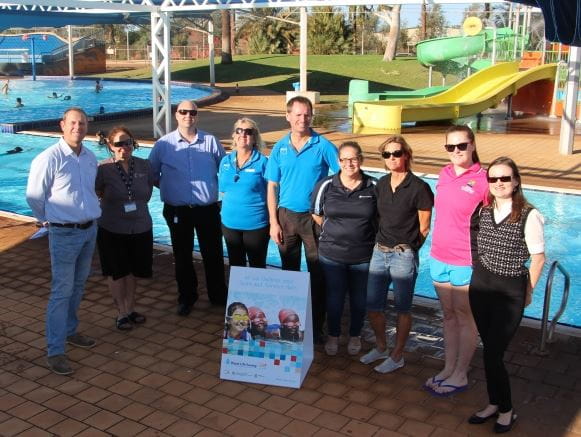Swim and Survive skills for the Pilbara
Recent data revealed that children in regional and remote areas of WA are 5 times more likely to drown that those in the Perth metro area. Between 2003 and 2013 28 per cent of drowning deaths in 5-14 year age group involved Aboriginal children.
The Royal Life Saving Society WA is working hard to address these statistics, by focusing attention on swimming and lifesaving programs for children in regional and remote areas, with a special focus on remote aboriginal communities.
Throughout this term a group of seven aboriginal children from the Youth Involvement Council have been attending a Swim and Survive program every Monday afternoon at the South Hedland Aquatic Centre, learning skills that could one day save their life.
Yesterday we showcased this program, inviting important stakeholders from across the Pilbara region to view the children attending these classes, giving them an opportunity to see the impact the program is having, and encouraging local involvement to ensure these communities have access to vital swimming and water safety education into the future.
Royal Life Saving WA’s Swim and Survive Access and Equity program was developed to ensure that people from at-risk communities have access to swimming and water safety programs. Royal Life Saving Society WA Senior Manager Swimming and Water Safety Education Trent Hotchkin says “Our concern is that too many people from regional and remote communities are not participating in these programs and therefore not gaining the swimming and survival skills to participate safely, and that needs to change. This program aims to break down barriers to participation amongst these communities such as cost and access to venues and programs.”
Royal Life Saving WA is committed to taking a leadership role and working with these high-risk communities to develop their water skills and knowledge and ensure that every Western Australian has the opportunity to learn to Swim and Survive, regardless of their cultural background or where they live. We are not only providing Swim and Survive classes for these children, but also Heart Beat Club CPR classes for parents, and water safety talks for parents and children in these at-risk communities.
The Royal Life Saving Society WA and BHP Billiton have shared a long and successful partnership delivering a range of water safety drowning prevention programs for high-risk communities in WA including the Swim and Survive Access and Equity program. Since 2003, BHP Billiton has invested over $2.3 million towards the delivery of these programs and recently committed a further $2.4 million over the next five years to ensure that these programs continue to make an impact in the community.
Ms Bindi Gove, Senior Manager, Community at BHP Billiton says “Water recreation is a big part of the Western Australian lifestyle and water safety is an important safety issue in regional and remote areas. We hope our renewed partnership will improve the accessibility of water safety programs and include more members of the community in swimming education, so that our communities become safer places to live and work.
The State Government through the Department of Sport and Recreation and Lotterywest is also a major supporter of Swim and Survive Access and Equity in Western Australia. Sport and recreation builds stronger, healthier, happier and safer communities.
